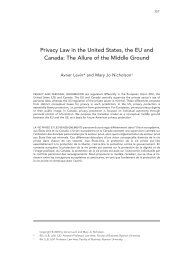The Criminal Phenomenon on the Internet: Hallmarks of ... - uoltj
The Criminal Phenomenon on the Internet: Hallmarks of ... - uoltj
The Criminal Phenomenon on the Internet: Hallmarks of ... - uoltj
You also want an ePaper? Increase the reach of your titles
YUMPU automatically turns print PDFs into web optimized ePapers that Google loves.
136 university <strong>of</strong> ottawa law & technology journal www.<strong>uoltj</strong>.caaverage <strong>of</strong> USA$312,780. However, this sum is largely due to <strong>the</strong> heavy fines intwo cases where <strong>the</strong> <strong>of</strong>fenders were fined USA$2 milli<strong>on</strong> and USA$7.8 milli<strong>on</strong>,which c<strong>on</strong>tributed to an excess <strong>of</strong> USA$228,000 for <strong>the</strong> calculati<strong>on</strong> <strong>of</strong> averagefine. If <strong>the</strong>se two cases are excluded from calculati<strong>on</strong>s, <strong>the</strong> average fine isapproximately USA$89,000.*5. DISCUSSION AND CONCLUSION<str<strong>on</strong>g>The</str<strong>on</strong>g> subjects <strong>of</strong> cybercrimes can be ei<strong>the</strong>r insiders or outsiders. Many studies havefound that insiders c<strong>on</strong>stitute a great threat to employers’ systems. However,younger juveniles are less likely to be employed and may represent <strong>the</strong> increasingnumber <strong>of</strong> outsiders engaged in cybercrimes. On <strong>the</strong> o<strong>the</strong>r hand, <strong>the</strong> nature <strong>of</strong>cybercrime is such that <strong>the</strong>re is no age limit. Any<strong>on</strong>e who can use computers and<strong>the</strong> internet can commit a cybercrime.In my opini<strong>on</strong>, <strong>the</strong> c<strong>on</strong>cept <strong>of</strong> white-collar crime cannot fit <strong>the</strong> situati<strong>on</strong><strong>of</strong> cybercrime. Although white-collar crime emphasizes <strong>the</strong> employment andsocial status <strong>of</strong> <strong>the</strong> criminals, I c<strong>on</strong>sider that <strong>on</strong>e <strong>of</strong> <strong>the</strong> most relevant factors inwhite-collar crime is <strong>the</strong> knowledge criminals have acquired from both <strong>the</strong>ir preemploymenteducati<strong>on</strong> and <strong>the</strong>ir occupati<strong>on</strong>al career. It is not oversimplified toview white-collar crime as a knowledge-based <strong>of</strong>fence, compared with violencebasedtraditi<strong>on</strong>al <strong>of</strong>fences. As opposed to <strong>the</strong>se two c<strong>on</strong>cepti<strong>on</strong>s, cybercrimecould be ei<strong>the</strong>r knowledge-based white-collar crime or knowledge-based cyberviolence. Overall, <strong>the</strong>re is a reluctant distincti<strong>on</strong> between cybercrime, white-collarcrime and even violent crime.However, it is reas<strong>on</strong>able to c<strong>on</strong>clude that when <strong>the</strong>re were fewcomputers, employees in <strong>the</strong> computer-related industries were am<strong>on</strong>g <strong>the</strong>small number <strong>of</strong> computer users. <str<strong>on</strong>g>The</str<strong>on</strong>g>y had more chances to commit an <strong>of</strong>fenceagainst <strong>the</strong>ir employers. With <strong>the</strong> prevalence <strong>of</strong> pers<strong>on</strong>al computers and <strong>the</strong>development <strong>of</strong> <strong>the</strong> internet, insiders maintain <strong>the</strong> advantage <strong>of</strong> having betterknowledge about access c<strong>on</strong>trol mechanisms, assets management systems, andoverall loopholes. Insider knowledge, c<strong>on</strong>venience, and directness encourageemployees to commit cybercrimes. As <strong>the</strong> United States Secret Service andCERT Coordinator Center’s study disclosed, minimal technical skill was requiredto launch cyberattacks <strong>on</strong> <strong>the</strong> banking and finance sector. 34In additi<strong>on</strong>, insiders are exposed to <strong>the</strong> negative psychological influencederived from <strong>the</strong>ir informati<strong>on</strong> work envir<strong>on</strong>ment. Shaw, Ruby and Post identifiedcharacteristics that increase <strong>the</strong> tendency towards illegitimate and harmfulbehaviour <strong>of</strong> <strong>the</strong> employees: “computer dependency, a history <strong>of</strong> pers<strong>on</strong>al andsocial frustrati<strong>on</strong>s (especially anger toward authority), ethical flexibility, a mixedsense <strong>of</strong> loyalty, entitlement, and a lack <strong>of</strong> empathy.” 35On <strong>the</strong> o<strong>the</strong>r hand, <strong>the</strong> <strong>of</strong>fences by insiders involve a less complicated34. Marisa Reddy Randazzo, Michelle Keeney, Eileen Kowalski, Dawn Cappelli, and Andrew Moore, “InsiderThreat Study: Illicit Cyber Activity in <strong>the</strong> Banking and Finance Sector,” Technical Report, CMU/SEI-2004-TR-021 (Carnegie Mell<strong>on</strong> S<strong>of</strong>tware Engineering Institute, 2005), at pp. 9, 23. Insider was defined as “current or former employeesor c<strong>on</strong>tractors.” ibid at p. 5.35. Shaw, Ruby, and Post, “<str<strong>on</strong>g>The</str<strong>on</strong>g> Insider Threat” supra note 23 at “Pers<strong>on</strong>al and Cultural Vulnerabilities.“









